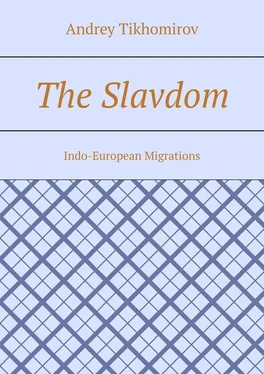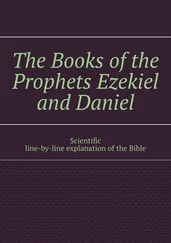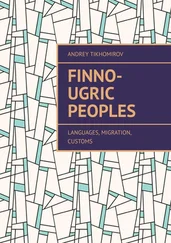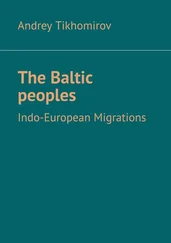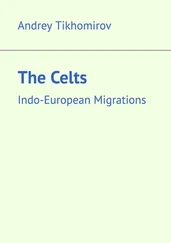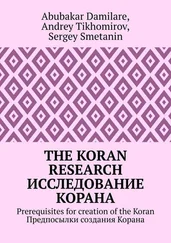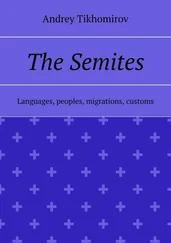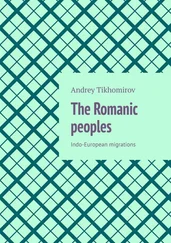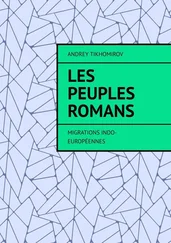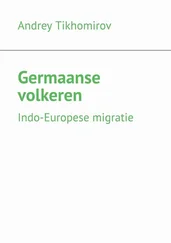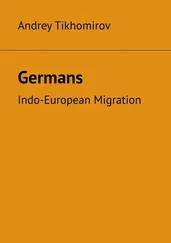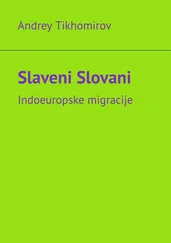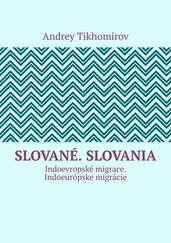Andrey Tikhomirov - The Slavdom. Indo-European Migrations
Здесь есть возможность читать онлайн «Andrey Tikhomirov - The Slavdom. Indo-European Migrations» — ознакомительный отрывок электронной книги совершенно бесплатно, а после прочтения отрывка купить полную версию. В некоторых случаях можно слушать аудио, скачать через торрент в формате fb2 и присутствует краткое содержание. ISBN: , Жанр: Языкознание, История, на английском языке. Описание произведения, (предисловие) а так же отзывы посетителей доступны на портале библиотеки ЛибКат.
- Название:The Slavdom. Indo-European Migrations
- Автор:
- Жанр:
- Год:неизвестен
- ISBN:9785449827043
- Рейтинг книги:4 / 5. Голосов: 1
-
Избранное:Добавить в избранное
- Отзывы:
-
Ваша оценка:
- 80
- 1
- 2
- 3
- 4
- 5
The Slavdom. Indo-European Migrations: краткое содержание, описание и аннотация
Предлагаем к чтению аннотацию, описание, краткое содержание или предисловие (зависит от того, что написал сам автор книги «The Slavdom. Indo-European Migrations»). Если вы не нашли необходимую информацию о книге — напишите в комментариях, мы постараемся отыскать её.
The Slavdom. Indo-European Migrations — читать онлайн ознакомительный отрывок
Ниже представлен текст книги, разбитый по страницам. Система сохранения места последней прочитанной страницы, позволяет с удобством читать онлайн бесплатно книгу «The Slavdom. Indo-European Migrations», без необходимости каждый раз заново искать на чём Вы остановились. Поставьте закладку, и сможете в любой момент перейти на страницу, на которой закончили чтение.
Интервал:
Закладка:
In the second century BC between the upper reaches of the Western Bug and the Middle Dnieper, that is, in the southern part of Belarus and in the forest-steppe Northern Ukraine, right up to Kiev in the south and Bryansk in the north, a Zarubin culture emerges. It is believed that the centers of the formation of this culture were in the western part of this territory. For four hundred years, the Zarubinets tribes were the only and numerous population of the forest-steppe Dnieper and Polesie, that is, those territories that are considered as ancient Slavic lands in eastern Europe. This culture has absorbed the traditions of a number of Proto-Slavic cultures, developed on their basis and on the territory that they occupied.
Settlements of the Zarubinets culture were located on the steep banks of the rivers, strengthened by tyn. People lived in rectangular ground huts. From the beginning of our era, rectangular half-dugouts, with a gable roof, a fireplace or a stove, have become the predominant type of dwellings. This type of dwelling was preserved until the Middle Ages with almost no changes in most Slavic tribes. There were cellar pits near the dwelling. The basis of the economy was hoe farming and domestic cattle breeding. People raised cows, horses, sheep and pigs. Iron axes, sickles, grain graders, arrowheads, harpoons and fishing hooks, a lot of jewelry and pottery were discovered on the Chaplinsky settlement.
However, the most characteristic of this culture is the so-called fields of funeral urns. This rite was also known among the ancient Slavs, and at the turn of our era it becomes dominant. Near Kiev, two large cemeteries are known – Zarubinetsky and Korchevatovsky. Excavating them, archaeologists met mostly burnt bones and pottery. In addition, there are iron knives, bronze brooches (clasps), pins and bracelets. Sometimes iron tips of spears come across. Among the archaeological materials of the Zarubinets culture, Roman and Celtic things are often found, testifying to the connection of the ancient Slavs with the Black Sea and Western Europe. Over time, the tribes of the Zarubinets culture advance north into the lands of the Baltic states, bringing elements of their culture and, above all, numerous iron products characteristic of the Zarubinets culture. Zarubinets tribes mastered the production of iron in perfection at that time.
Martynov A.I. in the book “Archeology of the USSR”, publishing house “Higher School”, M., 1973, p. 243. writes: “Iron was mined by them from the swamp ores, smelting was carried out in small raw-iron furnaces. Iron objects are very diverse: knives, axes, chisels, celts, chisels, sickles, pink salmon braids, arrowheads and darts, bit and fishing hooks.”
Anatoly Kim in the book “Fedina’s hut”, publishing house “Malysh”, M., 1988, writes about the ancient method of metallurgists (p. 23): “Here, Fedya, once burned coal, and the coal-burner worked at this place named after Aleksashka Zhukov, “explained the grandfather.” Before, all the blacksmiths worked on charcoal, and the factories used that kind of coal. they stood up to each other, made large piles of logs like stacks of logs, then covered these woodpiles with earth, and from below through firewood was lit… Logs were spoiled, but they could not burn with flame, therefore they did not burn into ashes, but were rotted into coal. It took a long time until all the logs were completely smoldered, then they chopped off the crust from it. Under it was coal – hard, sonorous. They smashed him with nuts and stuffed them with baggy bags. These were healthy bags, planted! And in these bags they brought coal out of the woods on sleighs, carts. I also transported winter coal when there was no other business … " Thus, various forms resembling a cross were used in ancient times for ignition.
Modern archaeological research proves that the homeland of the Indo-Europeans is the region of the South Urals, where they formed as a single language group.
Communities are created, first on the basis of common origin – childbirth, and as marketable products increase, a large family community is formed, consisting of phratry, i.e. several genera. Then the neighboring community in the form of a tribe, the next step – the union of tribes, leading, in turn, to the formation of the people, and then the state. But for any community, a community of interests is also necessary, in this case, the protection of metallurgists and their products. So there were settlements of ancient metallurgists, and in particular, the Arkaim culture of the South Urals. Similar settlements were found in Europe, in Germany near Dresden and Leipzig, as well as in Austria and Slovakia, under the age of 7 thousand years. After the end of natural resources, the settlements were “closed”, the ditches were filled up, and the remains of the dwellings were burned.
The country of cities is the conditional name of the territory in the Southern Urals, within which ancient cities and fortified settlements of the Sintash culture of the Middle Bronze Age were found (about 2000 BC), one culture.
Settlements were discovered in the 70s – 80s. XX century. One of the first archaeological complexes found was an ancient settlement on the Sintashty river (a tributary of Tobol), due to which the settlement itself was named after the South Ural River. Soon after the discovery of other cities, archaeologists began to use the term “Sintashta culture.” This “country” is located in the Chelyabinsk region, Orenburg region, Bashkortostan and northern Kazakhstan. Cities are located on the territory with a diameter of 350 km.
All settlements are united by a similar type of structure, the organization of urban infrastructure, building materials, and the existence time. As well as the same topographic logic. The hillforts are clearly visible in aerial photographs. After 4,000 years, the skeletons of cities clearly appear against the backdrop of the natural landscape, plowed fields. There comes an awareness of the skill of the engineers who designed and created such system cities. The cities themselves were most suitable for life. Firstly, they provided protection from external enemies, and secondly, in the cities premises were made for the life and work of artisans, saddlers, potters, and metallurgists. Inside the cities there is a storm sewer that takes water out of the settlement. Near the cities burial grounds were organized, animal pens were built. All fortified settlements were made in three different forms: round (8—9 pieces); oval (about 5); rectangular (about 11). The term “country” appropriately characterizes this location of cities. In addition to the fact that all the fortified settlements were built on a compact territory at the same time, in the same style and using the same engineering solutions, similar materials, other unifying properties are visible.
On the vast territory of the steppes in the ancient era to the west of the Urals lived the tribes of the so-called Srubnaya, and to the east – the Andronovo culture, the latter covering the region from the Urals to Altai and the Yenisei. Andronovites, who spoke one of the dialects of the ancient Iranian language (Indo-European group), raised cattle and small cattle, horses, engaged in fishing. In the southern Urals, traces of floodplain agriculture were also identified. Andronovo society was considered rather backward and archaic, as evidenced, in particular, by the poverty of their burials. Earthenware, bronze jewelry, less often tools and weapons were usually placed in the grave with the deceased.
According to Videvdat (the first book of the Avesta, a collection of sacred books of the ancient Iranian religion, a kind of Iranian continuation of the Vedas), the ancestral home of the ancient Iranians is Airyanem Vaejah (Avest. Airyanem Vaejah, “Aryan space”). This country is described as an endless plain through which the beautiful river Daitya (Vahvi-Datiya) flows.
Читать дальшеИнтервал:
Закладка:
Похожие книги на «The Slavdom. Indo-European Migrations»
Представляем Вашему вниманию похожие книги на «The Slavdom. Indo-European Migrations» списком для выбора. Мы отобрали схожую по названию и смыслу литературу в надежде предоставить читателям больше вариантов отыскать новые, интересные, ещё непрочитанные произведения.
Обсуждение, отзывы о книге «The Slavdom. Indo-European Migrations» и просто собственные мнения читателей. Оставьте ваши комментарии, напишите, что Вы думаете о произведении, его смысле или главных героях. Укажите что конкретно понравилось, а что нет, и почему Вы так считаете.
